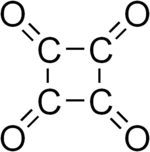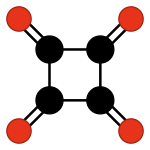Cyclobutaantetron
| Cyclobutaantetron | ||||
|---|---|---|---|---|
| Structuurformule en molecuulmodel | ||||

| ||||
Structuurformule van cyclobutaantetron
| ||||

| ||||
| Algemeen | ||||
| Molecuulformule | ||||
| IUPAC-naam | Cyclobutaan-1,2,3,4-tetraon | |||
| Andere namen | Tetraoxocyclobutaan | |||
| Molmassa | 112,040 g/mol | |||
| SMILES | O=C1C(=O)C(=O)C1=O
| |||
| CAS-nummer | 76719-54-5 | |||
| PubChem | 5488007 | |||
| Wikidata | Q3008466 | |||
| Waarschuwingen en veiligheidsmaatregelen | ||||
| ||||
Cyclobutaantetron, ook wel tetraoxocyclobutaan genoemd, is een organische verbinding[1] met de formule , of met iets meer nadruk op de structuur ervan: ; het viervoudige keton van cyclobutaan. Het kan gezien worden als een oxide van koolstof, het tetrameer van koolstofmonoxide.
De verbinding lijkt thermodynamisch instabiel te zijn.[2] In 2000 was er nog geen syntheseroute bekend om deze stof in voldoende grote hoeveelheden te maken om de bestudering ervan mogelijk te maken.[3][4] Wel is het kortstondig bestaan ervan aangetoond in massaspectrometrische bepalingen.[5]
Verwante verbindingen
[bewerken | brontekst bewerken]Cyclobutaantetron kan beschouwd worden als het ongeladen evenbeeld van het sqaraat-ion, , dat wel stabiel is en beschreven is sinds 1959.[6]
De verbinding octahydroxycyclobutaan of cyclobutaanoctaol, , wordt soms beschreven als "gehydrateerd tetraoxocyclobutaan".[7]
- Dit artikel of een eerdere versie ervan is een (gedeeltelijke) vertaling van het artikel Cyclobutanetetrone op de Engelstalige Wikipedia, dat onder de licentie Creative Commons Naamsvermelding/Gelijk delen valt. Zie de bewerkingsgeschiedenis aldaar.
- Verwijzingen in de tekst
- ↑ Guo, J.-C., Hou, G.-L., Li, S.-D., Wang, X.-B. (2012). Probing the Low-Lying Electronic States of Cyclobutanetetraone (C4O4) and Its Radical Anion: A Low-Temperature Anion Photoelectron Spectroscopic Approach. Journal of Physical Chemistry A 3 (3): 304–308. PMID 26285843. DOI: 10.1021/jz201593z.
- ↑ Jiao, H., Frapper, G., Halet, J.-F., Saillard, J.-Y. (2001). Stability of Tetraoxocyclobutane Revised: Perturbation Theory and Density Functional Scheme. Journal of Physical Chemistry Letters 105 (24): 5945–5947. DOI: 10.1021/jp010738i.
- ↑ Rubin, M. B., Gleiter, R. (2000). The Chemistry of Vicinal Polycarbonyl Compounds. Chemical Reviews 100 (3): 1121–1164. PMID 11749259. DOI: 10.1021/cr960079j.
- ↑ Seitz, G., Imming, P. (1992). Oxocarbons and pseudooxocarbons. Chemical Reviews 92 (6): 1227–1260. DOI: 10.1021/cr00014a004.
- ↑ Schröder, D., Schwarz, H., Dua, S., Blanksby, S. J., Bowie, J. H. (1999). Mass spectrometric studies of the oxocarbons CnOn (n = 3–6). International Journal of Mass Spectrometry 188 (1–2): 17–25. DOI: 10.1016/S1387-3806(98)14208-2.
- ↑ Cohen, S., Lacher, J. R., Park, J. D. (1959). Diketocyclobutanediol. Journal of the American Chemical Society 81 (13): 3480. DOI: 10.1021/ja01522a083.
- ↑ Skujins, S., Delderfield, J., Webb, G. A. (1967). A mass spectrometric study of some monocyclic polycarbonyl compounds. Tetrahedron 24 (13): 4805–4817. DOI: 10.1016/S0040-4020(01)98676-4.



